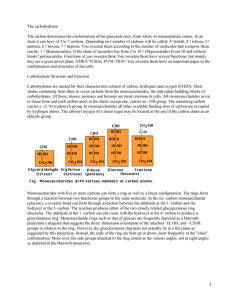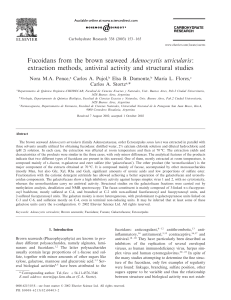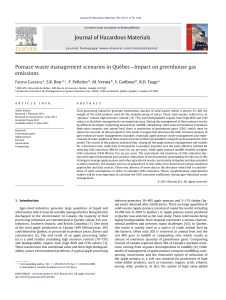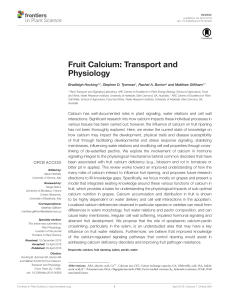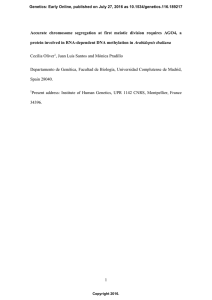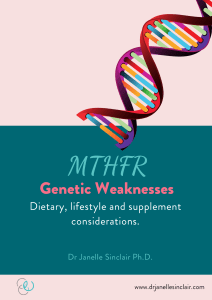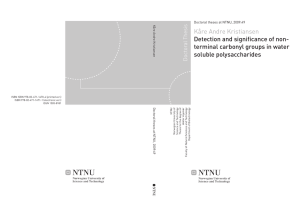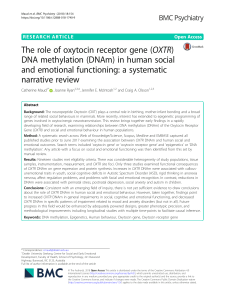Subido por
LUISA FERNANDA OROZCO DIAZ
Pectin from Food Waste: Composition & Content Analysis
Anuncio
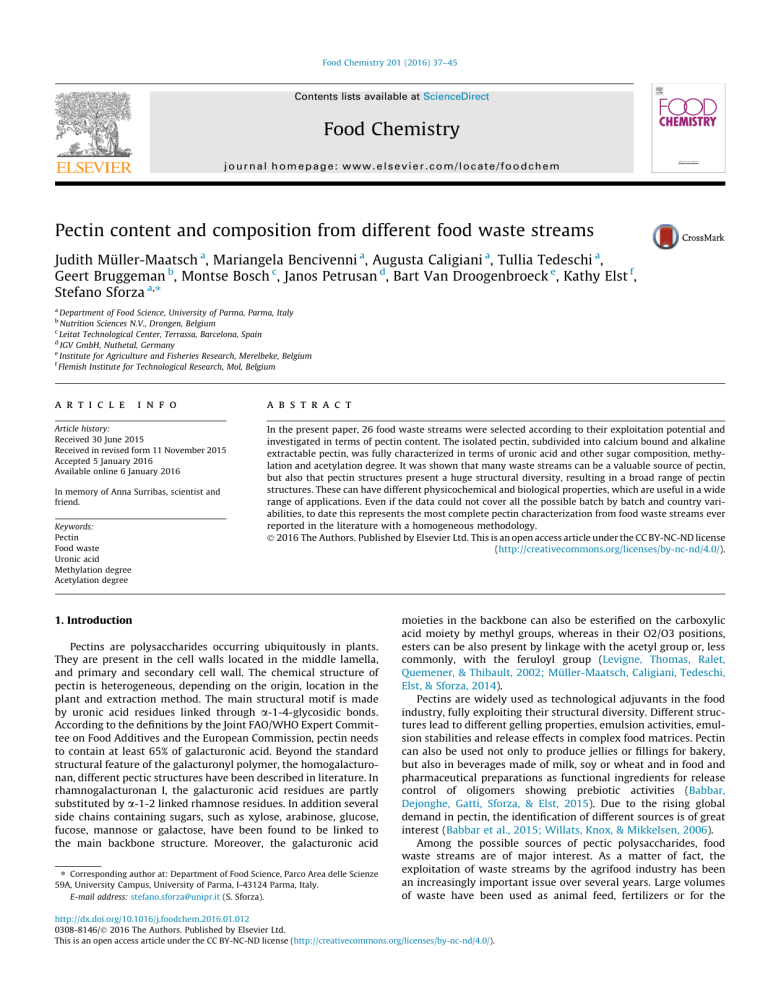
Food Chemistry 201 (2016) 37–45 Contents lists available at ScienceDirect Food Chemistry journal homepage: www.elsevier.com/locate/foodchem Pectin content and composition from different food waste streams Judith Müller-Maatsch a, Mariangela Bencivenni a, Augusta Caligiani a, Tullia Tedeschi a, Geert Bruggeman b, Montse Bosch c, Janos Petrusan d, Bart Van Droogenbroeck e, Kathy Elst f, Stefano Sforza a,⇑ a Department of Food Science, University of Parma, Parma, Italy Nutrition Sciences N.V., Drongen, Belgium Leitat Technological Center, Terrassa, Barcelona, Spain d IGV GmbH, Nuthetal, Germany e Institute for Agriculture and Fisheries Research, Merelbeke, Belgium f Flemish Institute for Technological Research, Mol, Belgium b c a r t i c l e i n f o Article history: Received 30 June 2015 Received in revised form 11 November 2015 Accepted 5 January 2016 Available online 6 January 2016 In memory of Anna Surribas, scientist and friend. Keywords: Pectin Food waste Uronic acid Methylation degree Acetylation degree a b s t r a c t In the present paper, 26 food waste streams were selected according to their exploitation potential and investigated in terms of pectin content. The isolated pectin, subdivided into calcium bound and alkaline extractable pectin, was fully characterized in terms of uronic acid and other sugar composition, methylation and acetylation degree. It was shown that many waste streams can be a valuable source of pectin, but also that pectin structures present a huge structural diversity, resulting in a broad range of pectin structures. These can have different physicochemical and biological properties, which are useful in a wide range of applications. Even if the data could not cover all the possible batch by batch and country variabilities, to date this represents the most complete pectin characterization from food waste streams ever reported in the literature with a homogeneous methodology. Ó 2016 The Authors. Published by Elsevier Ltd. This is an open access article under the CC BY-NC-ND license (http://creativecommons.org/licenses/by-nc-nd/4.0/). 1. Introduction Pectins are polysaccharides occurring ubiquitously in plants. They are present in the cell walls located in the middle lamella, and primary and secondary cell wall. The chemical structure of pectin is heterogeneous, depending on the origin, location in the plant and extraction method. The main structural motif is made by uronic acid residues linked through a-1-4-glycosidic bonds. According to the definitions by the Joint FAO/WHO Expert Committee on Food Additives and the European Commission, pectin needs to contain at least 65% of galacturonic acid. Beyond the standard structural feature of the galacturonyl polymer, the homogalacturonan, different pectic structures have been described in literature. In rhamnogalacturonan I, the galacturonic acid residues are partly substituted by a-1-2 linked rhamnose residues. In addition several side chains containing sugars, such as xylose, arabinose, glucose, fucose, mannose or galactose, have been found to be linked to the main backbone structure. Moreover, the galacturonic acid ⇑ Corresponding author at: Department of Food Science, Parco Area delle Scienze 59A, University Campus, University of Parma, I-43124 Parma, Italy. E-mail address: [email protected] (S. Sforza). moieties in the backbone can also be esterified on the carboxylic acid moiety by methyl groups, whereas in their O2/O3 positions, esters can be also present by linkage with the acetyl group or, less commonly, with the feruloyl group (Levigne, Thomas, Ralet, Quemener, & Thibault, 2002; Müller-Maatsch, Caligiani, Tedeschi, Elst, & Sforza, 2014). Pectins are widely used as technological adjuvants in the food industry, fully exploiting their structural diversity. Different structures lead to different gelling properties, emulsion activities, emulsion stabilities and release effects in complex food matrices. Pectin can also be used not only to produce jellies or fillings for bakery, but also in beverages made of milk, soy or wheat and in food and pharmaceutical preparations as functional ingredients for release control of oligomers showing prebiotic activities (Babbar, Dejonghe, Gatti, Sforza, & Elst, 2015). Due to the rising global demand in pectin, the identification of different sources is of great interest (Babbar et al., 2015; Willats, Knox, & Mikkelsen, 2006). Among the possible sources of pectic polysaccharides, food waste streams are of major interest. As a matter of fact, the exploitation of waste streams by the agrifood industry has been an increasingly important issue over several years. Large volumes of waste have been used as animal feed, fertilizers or for the http://dx.doi.org/10.1016/j.foodchem.2016.01.012 0308-8146/Ó 2016 The Authors. Published by Elsevier Ltd. This is an open access article under the CC BY-NC-ND license (http://creativecommons.org/licenses/by-nc-nd/4.0/). 38 J. Müller-Maatsch et al. / Food Chemistry 201 (2016) 37–45 generation of bio-energy, but recently extraction of more valuable components in the residues is the subject of many research projects (Pfaltzgraff, de Bruyn, Cooper, Budarin, & Clark, 2013). These high-value compounds can be classified as insoluble (fibers), water-soluble or lipid soluble compounds (Schieber, Stintzing, & Carle, 2001). Innovative products coming from waste streams can therefore include dietary fibers with different technological and nutritional properties as well as food additives (e.g. bioflavours) and bioadsorbents (e.g. wastewater treatment) (Laufenberg, Kunz, & Nystroem, 2003). In this line of research, several food wastes, such as apple, citrus, sugar beet, pea and cauliflower, have been investigated in order to isolate pectin. (McKnee & Latner, 2000). However, a detailed characterization of the amount and the structure of the pectin in different waste streams, which is essential in order to assess their potential techno- and biofunctionality, is still largely incomplete. In the present paper, 26 food waste streams selected according to their exploitation potential (mainly due to their potential nutritional properties, quantities produces and seasonality) in the framework of the EU project NOSHAN (EU Grant Agreement n° 312140), have been investigated regarding its pectin content, fully characterizing the isolated pectin in terms of uronic acid and other sugar composition, methylation and acetylation degree. Even if the data could not cover all the possible batch by batch and country variabilities, it is shown that many waste streams can be a valuable source of pectin. Pectin structures also present a huge structural diversity, resulting in a broad range of pectin structures, which can have different physicochemical and biological properties that are useful in a wide range of applications. To date, this represents the most complete pectin characterization from food waste streams ever reported in the literature. 2. Materials and methods 2.1. Materials The following samples coming from industrial processing plants all around Europe were considered: sugar beet flakes, apple pomace, pumpkin without kernels, pea pod, cabbage fresh and sour, sour cucumber, onion hull, apple cake, seabuckthorn pulp, seabuckthorn seed (press cake), pumpkin kernel cake, parsley, hop, rapeseed press cake, sabal (provided by IGV GmbH, Germany, through collection at local plants), olive pomace, orange peels, grape pomace (provided by Leitat Technological center, Spain, through collection at local plants), tomato skins (provided by University of Parma, Italy, through collection at local plants), berries (provided by Flemish Institute of Technological Research, Belgium, through collection at local plants), whole apples, whole pears, belgian endive root and leaves, leek (provided by the Institute for Agriculture and Fisheries Research, Belgium, through collection at local plants). 2.2. Dry matter determination About 5 g of sample were weighed and dried for 4 h in an oven preheated to 103 °C. After cooling for 30 min they were weighed again and this value was taken as the dry matter content. 2.3. Cell wall isolation Isolation of the cell wall was performed adapting the method by Melton and Smith (2001). Twenty-five gram of sample was ground to a powder, mixed with 100 ml 80% phenol- 0.5 M HEPES buffer (w/v) and homogenized with an Ultraturrax T-50 basic (IKAWerke, Staufen im Breisgau, Germany, 2–3 min, 4,000 rpm). The mixture was separated in a centrifuge, model 5804 (Eppendorf AG, Hamburg, Germany) by centrifuging for 20 min at 3220g at room temperature in HDPE centrifuge bottles, and the supernatant removed. The separation of the soluble cell matrix contents was done using 50 mM HEPES buffer (pH 6.7). The pellet was treated (incubation 6 and 24 h) with DMSO 90% (v/v) and furthermore incubated 1 h at 40 °C with 200 U porcine pancreatic a-amylase stabilized by 20 mM HEPES buffer with 20 mM CaCl2 (pH 6.9), to remove starch from the samples. The pellet was washed with 20 mM HEPES buffer with 20 mM CaCl2 (pH 6.9) and the supernatant removed. 2.4. Sequential extraction The isolation method followed instructions by Melton and Smith (2001). Cell walls of 25 g plant tissue were treated twice (6 and 12 h) with 50 mM trans-1,2-diaminocyclohexane-N,N,N, N-tetraacetic acid (CDTA) in 50 mM potassium acetate buffer (pH 6.5), to extract the chelating agent soluble solids (CASS). The supernatant was separated in a centrifuge model 5804 (Eppendorf AG, Hamburg, Germany) by centrifuging for 20 min at 3220g at room temperature in HDPE centrifuge bottles and dialyzed with 0.1 M ammonium acetate buffer (pH 6.5, 1 day, 3 changes, 4 °C) followed by H2O (3 days, 3 changes at 4 °C). The solution was freeze-dried (LIO 5P, VWR International PBI Milano, Italy) and the residue was weighted to determine the yield of CASS related to the dry matter content of the food waste streams. The pellet was treated with 50 mM Na2CO3/20 mM NaBH4 twice (16 and 2 h) at 4 °C to extract the dilute alkaline soluble solids (DASS). The supernatant was separated in a centrifuge model 5804 (Eppendorf AG, Hamburg, Germany) by centrifuging for 20 min at 3220g at room temperature in HDPE centrifuge bottles and neutralized using acetic acid and dialyzed with H2O (3 days, 3 changes, 4 °C). The solution was freeze-dried (LIO 5P, VWR International PBI Milano, Italy) and the residue was weighted to determine the yield of DASS related to the dry matter content of the food waste streams. The total pectin yield was taken as the combined weights of the freeze-dried CASS and DASS related to the dry matter content of the food waste streams. 2.5. Uronic acid content Sample preparation and measurement followed instructions by Melton and Smith (2001) with galacturonic acid as a standard. 10 mg of freeze-dried pectin samples were hydrolyzed by adding 2 ml of concentrated sulfuric acid for 10 min, under constant stirring and cooling in an ice bath. Then 0.5 ml of bidistilled water was added, the mixture was stirred and further diluted with a further 5 ml of bidistilled water. The samples were was separated in a centrifuge model 5804 (Eppendorf AG, Hamburg, Germany) by centrifuging for 20 min at 3220g at room temperature in HDPE centrifuge bottles and the supernatant was used for the colorimetric assay as follows. To 400 ll of supernatant or standard (galacturonic acid in water at different concentrations ranging from 25 lg/400 ll until 300 lg/400 ll), 40 ll of 4 M sulfamic acid/potassium sulfamate solution (pH 1.6) and 2.4 ml 75 mM sodium tetraborate/sulfuric acid solution were added. The mixture was heated (100 °C) for 20 min and then cooled. To the sample control, 80 ll 0.5% NaOH were added to determine the sugar colouring. To the sample and standard, 80 ll 255 M m-hydroxydiphenyl in 0.5% NaOH was added and the absorbance was measured after 10 min at 525 nm against a water blank in a UV/VIS LAMBDA BIO 20 spectrophotometer (Perkin Elmer, Waltham, MA, USA). J. Müller-Maatsch et al. / Food Chemistry 201 (2016) 37–45 2.6. Degree of methylation and acetylation The method previously published by Müller-Maatsch et al. (2014) was followed. 30 mg of freeze-dried pectin samples were combined with 1 ml 0.4 M NaOH and stirred for 2 h at room temperature in capped tubes. Afterwards the supernatant was separated in a centrifuge model 5804 (Eppendorf AG, Hamburg, Germany) by centrifuging for 20 min at 3220g at room temperature in HDPE centrifuge bottles, followed by the addition of 100 ll of internal standard solution (10 mg 3-(trimethylsilyl) propionate-d4 (TSP) in 5 ml D2O) used to quantify the methanol and the acetic acid. The supernatant was filtered using a syringe equipped with 0.4 lm nylon filter and transferred in NMR-tubes. 1H NMR spectra were acquired on a VARIAN-INOVA 600 MHz spectrometer, equipped with a triple resonance inverse probe (HCN), operating at 599.736 MHz for proton. Spectra were acquired at 298 K, with 32 K complex points, using a 90° pulse length. 128 scans were acquired with a spectral width of 7196.8 Hz, an acquisition time of 2.53 and a relaxation delay (d1) of 5 s. The experiments were carried out with water suppression by low power selective water signal presaturation during 5 s of the relaxation delay. The NMR spectra were processed by MestreC software. The spectra were Fourier transformed with FT size of 64 K and 0.2 Hz line-broadening factor, phased and baseline corrected, and referenced to 3-(trimethylsilyl)-propionate-d4 (TSP) peak (0 ppm). The quantitative determination of acetic acid and methanol was obtained by manual integration of the corresponding signals (1.92 ppm for acetic acid, 3.36 for methanol) and the comparison with TSP area. The values obtained by the integration were converted in mass value (mg) according to the formula reported in Müller-Maatsch et al. (2014). The accuracy of the quantitative data was assured by the relaxation delay, determined by T1 measurements, which was set in order to allow the complete relaxation of the nuclei. 2.7. Neutral sugars Pectin samples were hydrolysed following the method previously published by Melton and Smith (2001). 10 mg of pectin sample were hydrolyzed with 3 ml 2 M triflouracetic acid under nitrogen for 60 min at 121 °C. To the hydrolysed mixture, 1 ml phenyl-b-D-glucopyranoside (500 ppm) was added as internal standard. The samples were clarified by syringe filtration on nylon filters (40 lm) and the filtrate evaporated to dryness with nitrogen. With 1800 ll N-N-dimethylformamide and 200 ll N,O-Bis(tri methylsilyl)trifluoroacetamide (BSTFA) with trimethylchlorosilane (TMCS) the sugars were silylated for 60 min at 60 °C. The GC/MS analysis was carried out with a Agilent Technology 6890N Network GC System equipped with a 5973 MS Detector, using a capillary column HP-5MS 0.25 mm 30 m 0.25 lm, injection volume of 1 ll, initial temperature 60 °C, split injection (ratio 20:1), carrier gas helium, following this temperature ramp: 10 °C/min until 160 °C, then 10 °C/min until 220 °C, then 20 °C/min until 270 °C. 39 solutions first extract soluble pectic polysaccharides (Melton & Smith, 2001) yielding, after freeze drying, the chelating agent soluble solid (CASS, details in the experimental section). CDTA actually solubilises pectic polysaccharides supposedly by disrupting the ionic bridges between calcium and non-esterified galacturonic residues. Chelating agents enhance the extractability of the pectic polysaccharides in mild conditions and reduce the degradation and production of artefacts. This was the main reason for choosing this method, even if quite cumbersome, exactly because it is known to yield pectins with their native structure as intact as possible (Renard & Thibault, 1993) even if co-extraction of proteins (14–44% w/w according to Pustjens, Schols, Kabel, & Gruppen, 2013) or other polysaccharides as hemicelluloses (MateosAparicio, Redondo-Cuenca, & Villanueva-Suárez, 2010) can lead to aberrant estimations of the pectin content. This method might also lead to incomplete recovery of the ester-bound pectin fraction. Thus, in order to obtain the ester-bound pectin, an alkaline extraction with 50 mM Na2CO3/20 mM NaBH4 was then also performed on the residual from the extraction with CDTA yielding, after freeze drying, the diluted alkaline soluble solid (DASS, details in the experimental section). The DASS fraction contains the previous ester-bound pectin as well as traces of hemicelluloses. NaBH4 was added to alkaline solutions to reduce the reducing end of the polysaccharides and therefore prevent base peeling of polysaccharides (Melton & Smith, 2001). The total pectin content, also divided in the CASS and DASS fractions, is shown in Fig. 1 for the different food wastes, expressed in mg/g sample (as dry matter), in decreasing order of content. The highest levels of CASS were obtained from orange peel (126 mg/ g), pumpkin (85 mg/g) and parsley (47 mg/g), whereas the highest values of DASS came from pumpkin (150 mg/g), orange peels (121 mg/g), and endive roots (119 mg/g). As displayed in Fig. 1, the DASS pectin fraction was almost always the more consistent one (the lower bound represented by leek leaves, with a CASS/ DASS ratio of 0.21). Nevertheless, in few samples the CASS fraction was more abundant (olive pomace CASS/DASS ratio 1.27, grape pomace 1.45, tomato skins 3.24). Although the results cannot be considered representative of all the possible variations present in food waste streams in Europe, the homogeneous analytical methodology applied showed the impact of the processing technology on pectin yield and composition, as indicated by the differences between apple pomace (CASS 2.8. Statistical analysis All measurements were done in duplicate and the average values with the corresponding standard deviations were calculated. 3. Results The pectin content was determined for the two fractions of pectin, the one soluble in chelating agents (calcium-bound pectin) and the other one soluble in alkaline solution (ester linkage-bound pectin). According to the method applied here, chelating agent Fig. 1. Calcium bound (dark bars) and ester linkage bound (light bars) pectin in the different food waste streams, expressed as mg/g of dry matter. 40 J. Müller-Maatsch et al. / Food Chemistry 201 (2016) 37–45 Fig. 2. Uronic acid content in CASS (calcium-bound pectin), listed from left to right according to the total pectin content, expressed as mg/g of extracted pectin in the CASS fraction. 14 mg/g DM, DASS 41 mg/g DM) and apple cake (CASS 13 mg/g; DASS 73 mg/g). Also the different plant tissues with different pectin content obviously affected the yield: whole apple, less rich in skins, had a lower amount of pectin per gram of dry matter than the previously reported apple pomace and apple cake (CASS 10 mg/g DM, DASS 10 mg/g DM). Endive leaves (CASS 18 mg/g DM, DASS 85 mg/g DM) and endive roots (CASS 29 mg/g DM, DASS 102 mg/g DM) also showed a different pectin contents. The uronic acid content in the obtained polysaccharides is a good indication of the quality of the pectin in the extract. The amount of uronic acids in our samples was determined spectrophotometrically by using m-hydroxydiphenyl as a colouring agent, which is the common way to determine uronic acids in the literature (Melton & Smith, 2001). The results are reported in Fig. 2 (uronic acid content in CASS samples) and Fig. 3 (uronic acid content in DASS samples), expressed as mg of uronic acid for g of extracted pectin fraction. Samples are reported in the same order as Fig. 1, according to the decreasing content of total pectin. The amount of uronic acids in the extract can vary due to the presence of neutral sugars replacing galacturonic acids. Furthermore, the quality of the data can be affected by overestimation of uronic acid in some samples due to the interference in the spectrophotometrical measurement of extracted co-products, which might lead to 10–20% overestimation of the actual content of uronic acid. Taking into account these limitations of the applied method and the expected errors, the trends in galacturonic acid content were anyway very clear. Highest results in uronic acid content, and therefore mostly homogalacturonan, was extracted with chelating agents solution from onion hull (1146 mg/g CASS), orange peel (1099 mg/g CASS), leek (890 mg/g CASS), endive (993–1033 mg/g CASS), seabuckthorn pulp (1002 mg/g CASS) and fresh cabbage (934 mg/g CASS). Solids extracted in diluted alkaline solutions Fig. 3. Uronic acid content in DASS (dilute alkaline soluble pectin), listed from left to right according to the total pectin content, expressed as mg/g of extracted pectin in the DASS fraction. 41 J. Müller-Maatsch et al. / Food Chemistry 201 (2016) 37–45 Table 1 Profile and content of neutral sugars in CASS (calcium-bound pectin) and DASS (dilute alkaline soluble pectin). Orange peels Fresh pumpkins Leek leaves Endive roots Fresh cabbage Onion hulls Parsley Endive leaves Apple cake Pea pod Sour cabbage Sour cucumber Sugar beat flakes Pumpkin kernel cake Berries Apple pomace Rapeseed press cake Seabuckthorn pulp Hop Olive pomace Whole apple Tomato skins Grape pomace Whole pear CASS DASS CASS DASS CASS DASS CASS DASS CASS DASS CASS DASS CASS DASS CASS DASS CASS DASS CASS DASS CASS DASS CASS DASS CASS DASS CASS DASS CASS DASS CASS DASS CASS DASS CASS DASS CASS DASS CASS DASS CASS DASS CASS DASS CASS DASS CASS DASS Ara (mg/g pectin) Glc (mg/g pectin) Rha (mg/g pectin) Glu (mg/g pectin) Man (mg/g pectin) Xyl (mg/g pectin) Rib (mg/g pectin) Fuc (mg/g pectin) 136 ± 10 266 ± 38 32 ± 25 17 ± 2 17 ± 1 12 ± 7 31 ± 1 22 ± 8 54 ± 6 195 ± 21 14 ± 0 13 ± 5 65 ± 3 108 ± 10 20 ± 1 36 ± 8 58 ± 15 85 ± 7 129 ± 2 77 ± 28 145 ± 1 195 ± 45.51 19 ± 0.06 35 ± 1.74 298 ± 24.93 266 ± 74.65 32 ± 5.44 29 ± 2.13 40 ± 11.39 26 ± 2.44 73 ± 16.07 67 ± 2.73 76 ± 5.43 68 ± 18.87 97 ± 50.21 75 ± 9.05 43 ± 9.84 35 ± 25.41 159 ± 15.84 220 ± 30.98 79 ± 14.06 88 ± 12.21 19 ± 2.99 29 ± 9.15 12 ± 3.24 15 ± 3.07 64 ± 8.92 99 ± 1.19 35 ± 6 105 ± 22 12 ± 4 16 ± 1 21 ± 2 19 ± 9 13 ± 3 7±2 64 ± 10 158 ± 14 38 ± 18 107 ± 24 65 ± 1 131 ± 8 12 ± 1 20 ± 5 27 ± 2 26 ± 1 29 ± 1 16 ± 5 44 ± 5 63.47 ± 8 39.64 ± 1 122.73 ± 7 44.04 ± 0 50.16 ± 5 17.00 ± 4 22.68 ± 1 92.78 ± 35 30.16 ± 6 21.33 ± 2 16.91 ± 1 17.75 ± 1 18.09 ± 6 9.92 ± 4 16.45 ± 1 24.47 ± 4 19.75 ± 14 20.87 ± 7 27.83 ± 3 24.39 ± 16 38.46 ± 8 38.85 ± 0 102.94 ± 9 8.13 ± 2 9.63 ± 3 14.35 ± 1 29.87 ± 2 18 ± 4 37 ± 9 16 ± 11 16 ± 1 7±1 10 ± 6 14 ± 1 8±4 23 ± 4 39 ± 13 20 ± 4 21 ± 6 23 ± 1 36 ± 4 21 ± 0 33 ± 6 11 ± 1 22 ± 1 31 ± 4 19 ± 13 40 ± 1 41 ± 9 8±2 17 ± 1 36 ± 3 25 ± 9 21 ± 1 22 ± 3 14 ± 5 14 ± 2 39 ± 3 35 ± 0 9±1 8±2 12 ± 6 11 ± 0 16 ± 4 15 ± 13 53 ± 7 61 ± 11 15 ± 3 20 ± 3 8 ± 0.4 14 ± 3 10 ± 2 10 ± 2 25 ± 2 32 ± 1 11 ± 4 10 ± 1 10 ± 4 16 ± 1 6±1 2±2 6±1 1±1 20 ± 6 21 ± 1 18 ± 2 13 ± 5 17 ± 0 20 ± 1 5±1 5±1 27 ± 1 16 ± 1 14 ± 2 1±2 38 ± 0. 22 ± 4 7±1 7±1 7±2 5±3 24 ± 2 33 ± 1 36 ± 41 15 ± 2 73 ± 3 55 ± 2 10 ± 1 9±2 6±3 15 ± 0 8±2 6±6 34 ± 23 28 ± 4 16 ± 2 10 ± 2 7±1 6±3 3±1 12 ± 1 8±1 10 ± 6 traces 1±0 – – – 2±3 5±1 – – 4±0 – – – – 5±0 7±2 – – – – – – 16 ± 2 45 ± 1 – – – – – – 12 ± 3 – 8±1 9±2 – – 10 ± 2 8±6 – 11 ± 2 9±5 – 16 ± 0 38 ± 11 – 6±1 6±0 – 5±1 5±0 26 ± 30 13 ± 1 3±0 1±1 – 1±0 12 ± 1 26 ± 2 – ± 3±0 8±0 4±1 6±1 27 ± 5 – 107 ± 2 36 ± 18 – 20 ± 2 13 ± 0 26 ± 9 – – 32 ± 3 36 ± 1 – – 9 ± 13 6±5 30 ± 1 21 ± 4 8±4 9±1 27 ± 10 11 ± 7 18 ± 11 26 ± 18 47 ± 17 20 ± 6 13 ± 2 23 ± 13 6±2 8.89 ± 1 19.81 ± 2 37.26 ± 15 – – – – – – – – – – – – – – – – – – – – – – – – – – – – – – – – – 5±2 5±3 7±2 – – – – – – – – – – – – – – – – – – – – – – – – 2±0 5±0 3±0 6±1 – – – – – – – – – – – – – – – – 9±2 11 ± 6 – – 3±1 3±2 20 ± 17 – 7±0 3±1 – – – – – – were found to have highest yields in uronic acid in the case of apple pomace (1066 mg/g DASS), hop (974 mg/g DASS), seabuckthorn pulp (968 mg/g DASS), onion (958 mg/g DASS) and pea pod (949 mg/g DASS). In order to determine the neutral sugar contents, pectic polysaccharides extracted by chelating agents were then hydrolyzed using TFA, releasing the neutral sugars, even if a full hydrolysis of the polysaccharides was unlikely (Melton & Smith, 2001). Silylation of neutral sugars and other compounds was then performed, in order to make them amenable for GC–MS detection, as previously reported (Caligiani et al., 2013; Reinders & Thier, 1999). The results of the total amount of sugars occurring and the detailed composition are reported in Table 1. The concentration of neutral sugars of pectic polysaccharides again was found to be variable among the different samples, according to the different waste streams, the CASS and DASS fraction, the treatment of samples with same origins during food processing as well as different parts of one plant. Highest neutral sugar content in CASS extracts was found in sugar beet (386 mg/g CASS), pea pod (310 mg/g CASS) and olive pomace (305 mg/g CASS). Values for neutral sugar obtained in DASS reached 442 mg/g DASS in fresh cabbage, 422 mg/g DASS in orange peels and 373 mg/g DASS in olive pomace. Not surprisingly, samples with the lowest amount of uronic acid also had the highest amount of neutral sugars. The methylation and the acetylation degree was done after alkaline saponification (Levigne et al., 2002) by determining methanol and acetic acid by NMR after performing the saponification directly in alkaline deuterium oxide (Müller-Maatsch et al., 2014). The esterification degree is shown only for CASS (Fig. 4), as the extraction with diluted alkaline used for DASS causes the hydrolysis of the ester groups, thus making the esterification degree completely unreliable. Highest values in methylation degree were obtained in apple (whole apple 57%), even if after industrial processing this valued decreased (apple cake 36–40%), as well as in berries (42%), seabuckthorn (32%) and pear (30%). The acetylation degree has not been reported frequently on all samples analysed for pectic polysaccharides, also on account of the fact that it is lower than the methylation degree. Actually, the highest values were determined in sugar beet flakes (18%), rapeseed press cake (13 %) and pea pod (10%). 42 J. Müller-Maatsch et al. / Food Chemistry 201 (2016) 37–45 Fig. 4. Degree of esterification (in percentage) in CASS (calcium-bound pectin), listed from left to right according to the total pectin content. 4. Discussion 4.1. General The main aim of this study was to investigate the by-products of plant processing food industry for the potential content of valuable pectic polysaccharides. The data here presented, covering 26 different food wastes, cannot be considered a complete and exhaustive description of all the possible batch by batch variations in every waste stream analysed, nor covering for all the possible variations among different countries. Anyway, due to the homogeneous methodological approach applied, the analysed samples can be considered a meaningful survey of the waste streams considered, since the batches collected were the average mixtures generated at different stages of agri-food chain manufacturing sites, which process raw materials from different countries of Europe. The data obtained on the pectin content of the various food waste streams are discussed below, compared with the data reported in the literature (when available) on the corresponding content in the original food material. 4.2. Orange peel The highest yield of pectic polysaccharides was obtained in orange peel with 247 mg/g sample on dry matter basis. This is already a common source for pectins, which are usually extracted with acidic extractants. Different technologies were also evaluated reaching 154.7 mg/g (traditional heating), 181.3 mg/g (microwave) and 204.4 mg/g (Ultra high pressure) of pectin in orange peels (Guo et al., 2012). The CASS sugar composition consisted, beside uronic acid (of which 25% methylated), of arabinose (136 mg/g CASS) as the most abundant neutral sugar. DASS had instead more arabinose (266 mg/g DASS) and galactose (105 mg/g DASS), in agreement with a recent report (Chau & Huang, 2003). The high content of pectic polysaccharides and their composition indicate this waste stream as an ideal source of dietary fibre for nutritional factors (Chau & Huang, 2003) or as texturizer or stabilizer due to its gelling property and rheological behaviour in a variety of food, pharmaceutical and cosmetic products (Guo et al., 2012). 4.3. Pumpkin and pumpkin kernel cake In the literature, pumpkin polysaccharides from styrian oilpumpkin pulp extracted at pH 4 with the chelating agent EDTA yielded 24 mg/g of pectic material (Košťálová, Hromádková, & Ebringerová, 2013). Higher yields were obtained though by combining an acid extraction (42 mg/g) with a microwave treatment determining 113 mg/g pectic polysaccharides in squash pumpkin pulp (Yoo et al., 2012). The sum of pectic polysaccharides determined in this study were 235 mg/g sample dry matter, which is higher than previously reported, due to the fact that the whole pumpkin (pulp and peel) was used as sample material. Only small amounts of neutral sugars were found: arabinose (3.2% of CASS) and xylose (2.6% of CASS) had the highest values. The uronic acid extracted with a chelating agent solution (445 mg/g CASS; 536 mg/g DASS) was only partly esterified (18% methylation degree and 3% acetylation degree). The composition was reported in the literature as being 543 mg/g uronic acid, with a methylation degree of 28% in the extracts and a large amount of phenolic compounds, proteins and neutral sugars (Košťálová et al., 2013). Due to its behaviour in forming viscose solutions and surface tensions, similar to citrus peels, it can be used as food additive (Fissore, Rojas, Gerschenson, & Williams, 2013). Furthermore the extracts are suggested to have a positive effect on gut bacteria (Jun, Lee, Song, & Kim, 2006). Pumpkin kernel cake, on the other side, is a by-product of processing industry exploiting the valuable pumpkin seed oil. The extraction of pectic polysaccharides led to very low yields (29 mg CASS/g; 30 mg DASS/g) and with low uronic acid content indicating a large co-extraction of proteins, thus very little and low quality pectic material. 4.4. Leek Pectic polysaccharides of leek were extracted mainly by alkaline solutions (25 mg CASS/g; 119 mg DASS/g). Results of uronic acid and neutral sugars indicate a high amount of methylated uronic polysaccharides (DE 26%, DA 3%) with less side chains containing neutral sugars, mainly galactose. These results agree with the previously reported ones, which proposed that the presence of side chains containing galactose have a positive effect on the biological activity of these pectic polysaccharides (Kratchanova, Nikolova, Pavlova, Yanakieva, & Kussovski, 2010). 4.5. Belgian endive leaves and roots The extraction with chelating agents (roots 29 mg/g; leaves 19 mg/g) resulted in both samples in lower yields than the alkaline one (roots 102 mg/g; leaves 85 mg/g), indicating a higher content of bound pectin. The detection of uronic acid was very high in leaves, both CASS and DASS, as well as in roots CASS. Findings here are indicating a large amount of pectin, with a high methylation degree, particularly in roots (DE Roots 23% Leaves 12%; DA Roots 3%, Leaves 2%), with arabinose as the main neutral sugar. This composition strictly resembles sugar beet pectin. In the literature, the distribution of neutral sugars of endive pulp pectin extracted using enzymes led to different results. Though arabinose was also determined to be the main neutral sugar, higher values were obtained in the neutral sugars mannose, galactose and glucose. The value of galacturonic acid was less than that obtained with extraction by chemicals (Zykwinska et al., 2008). The higher yields of pectin in roots than in leaves was also suggested previously (VillanuevaSuárez, Redondo-Cuenca, Rodríguez-Sevilla, & de las Heras Martínez, 2003). 4.6. Fresh and sour cabbage The yield of pectic polysaccharides in fresh and fermented cabbage differed little when extracted with chelating agent solutions (Fresh 30 mg CASS/g; Sour 23 mg CASS/g) and more in alkaline solutions (Fresh 93 mg DASS/g; Sour 44 mg DASS/g). A similar J. Müller-Maatsch et al. / Food Chemistry 201 (2016) 37–45 effect in loss of dietary fibre was mentioned for cabbage while boiling and storing (Wennberg, Engqvist, & Nyman, 2003). The composition of pectic polysaccharides in fresh and sour cabbage ranged from homogalacturonans in CASS (uronic acid content 934 mg/g CASS) to galacturonans with a high amount of side chains containing arabinose and galactose in DASS. Galactose and arabinose rich pectic polysaccharides have been reported previously in fresh cabbage and are studied for their immunological activity (Westereng, Michaelsen, Samuelsen, & Knutsen, 2008). The methylation (Fresh 19%, sour 12%) and acetylation degree (fresh 5%, sour 4%) indicate that this pectic material might have good gelling properties, which have not been reported yet. 4.7. Onion Pectic substances extracted from onion hulls were composed mainly of uronic acids with a methylation degree of 19% and acetylation degree of 2%, indicative for highly polymerized polygalacturonates. These findings are in line with what has been previously reported in the literature, where also very efficient immunostimulating effects as well as physical properties were observed (Patra et al., 2013). 4.8. Parsley There has not been any research done on parsley pectin, so the values obtained in this paper of 47 mg/g in CASS and 67 mg/g DASS are the first reported ones. The extract had a uronic acid content between 867 mg/g CASS and 858 mg/g DASS, indicating a high purity of pectin. The neutral sugars detected were mainly arabinose (6.51% CASS; 10.75% DASS) and galactose (6.45% CASS; 13.06 % DASS). The low degree of methylation and acetylation indicates physical properties similar to pumpkin or sugar beet pectic polysaccharides. Due to the high amount of neutral sugars it could be used as functional food ingredient. 4.9. Apple, apple cake and apple pomace By-products of apple processing industry are after citrus fruits the second most used source of pectin (May, 1990). Three samples of apple origin were investigated in this paper. Whole apples, discarded from fresh consumption, apple cake and apple pomace from the fruit processing industry. Yields were higher in the processed products: apple 10 mg CASS/g, 10 mg DASS/g; apple cake 13 mg CASS/g, 74 mg/g DASS; apple pomace 14 mg CASS/g, 42 mg DASS/ g. Uronic acid content of the extracted pectic polysaccharides was in all three samples lower in the extraction with chelating agent (apple 488 mg/g CASS, apple cake 408 mg/g CASS, apple pomace 781 mg/g CASS) than in the diluted alkaline extraction (apple 656 mg/g DASS, apple cake 802 mg/g DASS, apple pomace 1067 mg/g DASS). CASS as well as DASS were rich in neutral sugars arabinose 6–9%, galactose 2–4%, rhamnose 1–4%, glucose 1–7% and xylose 1–5%. Traces of mannose and fucose were found as reported earlier (Renard & Thibault, 1993). The CASS fraction contained highly methylated galacturonans, but with a wide range (26– 60%). This data supports the decrease of methylation during juice production, likely due to the activity of pectin-methylesterase. 43 mentioned previously (Wheightman, Renard, & Thibault, 1995). There has not been any study yet reported on the technological application of pea hull pectin, despite the purity and high methylation degree. 4.11. Cucumber Pectic polysaccharides of cucumber (sour) were 27 mg CASS/g and 38 mg DASS/g. The CASS extract contained more homogalacturonans indicated by the high uronic content and small amounts of neutral sugar, mainly galactose and fucose. In contrast, the uronic acid content was lower in DASS with a high amount of neutral sugar (galactose, arabinose and fucose). Galacturonic residues were methylated at 25 % and partially acetylated 4%. As reported by McFeeters et al., the fermentation of cucumber led to a loss in esterification from 54% in fresh cucumber to 16% in fermented one (McFeeters & Armstrong, 1984). 4.12. Sugar beet Yields of pectic polysaccharides obtained from sugar beet pulp were 28 mg CASS/g and 32 mg DASS/g. These results are lower than previously reported, which can be explained by the different method used for the extraction (Oosterveld, Beldman, Schols, & Voragen, 1996). The composition of the fractions were in agreement with the literature (Yapo, Robert, Etienne, Wathelet, & Paquot, 2007): uronic acid content ranged between 653 mg/g CASS and 689 mg/g DASS and high values of arabinose and small amounts of galactose and rhamnose were detected. This indicates the occurrence of rhamnogalacturonan, arabinan and homogalacturonan in both extracts. The galacturonic residues in sugar beet are known to be both methylated (29%) and acetylated (18%) (Renard & Thibault, 1993). 4.13. Berries The by-product of berry juice production contained 25 mg CASS/g and 33 mg DASS/g which is in agreement with the yields reported from bilberry and black currant press cake (Hilz, Bakx, Schols, & Voragen, 2005). CASS was composed by 744 mg/g uronic acid with 42% methylation degree and 1% acetylation degree, arabinose, galactose and rhamnose. In DASS less uronic acid 596 mg/g and more neutral sugars were detected. Similar results were measured by Hilz et al. (2005), though the methylation degree and acetylation degree was different. Again, this might be explained by different sample pretreatment. 4.14. Rapeseed Extraction yields of pectic polysaccharides were low in rapeseed press cake (25 mg CASS/g; 23 mg DASS/g). In accordance with the literature, the uronic acid content ranged from 85 mg/g CASS to 102 mg/g DASS with high levels of arabinose and xylose (Eriksson, Anderson, & Aman, 1997). In CASS 25% of uronic acid was methylated and 13% esterified with acetic acid groups. The possibility of having proteins coextracted with the pectin fraction was mentioned previously in rapeseed meal (Pustjens et al., 2013). 4.10. Pea 4.15. Seabuckthorn pulp and see Extraction of pea pods yielded 10 mg CASS/g and 73 mg DASS/g, values which are in agreement with the total yield of pectic polysaccharides in literature (Mateos-Aparicio, Redondo-Cuenca, & Villanueva-Suárez, 2012). The pectic polysaccharide fractions were rich in uronic acid (70–95%), highly methylated (30%) and acetylated (10%), and rich in arabinose, xylose and galactose as The pulp of seabuckthorn was found to have more pectic polysaccharides (14 mg CASS/g and 25 mg DASS/g), compared to the by-product seabuckthorn seeds (6 mg CASS/g, 8 mg DASS/g). No further analysis was applied on the seed waste, given the very low amount of pectin. Extracts of the pulp contained high amounts of uronic acid, halfway esterified and partially acetylated, as well 44 J. Müller-Maatsch et al. / Food Chemistry 201 (2016) 37–45 as arabinose and galactose in accordance with literature (Dongowski, 1996). 4.16. Hop The extraction of pectic material from hops yielded 9 mg CASS/g and 18 mg DASS/g. Several neutral sugars were detected, with arabinose, galactose and xylose as the highest. The uronic residues were partially methylated (14%) and acetylated (7%). Similar findings of pectic extracts of hob using acidic solution were obtained previously (Oosterveld, Voragen, & Schols, 2002). 4.17. Grape pomace 11 g CASS/g and 8 mg DASS/g pectic polysaccharides were extracted from grape pomace. The larger amount was extracted by chelating agents as already reported for grape pomace of different varieties (Deng, Penner, & Zhao, 2011). A high uronic acid content was detected in CASS (894 mg/g CASS), low methylated (5%) with small amounts of arabinose and galactose as reported for grape pulp (Saulnier & Thibault, 1987). 4.18. Olive pomace Olive pomace, like grape pomace, has a low amount of pectic polysaccharides extractable by chelating agents (14 mg CASS/g) or diluted alkaline solution (11 mg DASS/g). CASS contains a high amount of uronic acid partially methylated and acetylated as well as high amounts of neutral sugars, mostly arabinose and rhamnose. Similar findings were reported by Jiménez et al. in untreated olive pulp (Jiménez et al., 2001). 5. Conclusion The investigation done here had the purpose to characterize the pectin composition of several waste streams of the plant processing industry. Although the data here reported do not exhaust all the possible variations possibly present in different batches and countries, this is the most complete survey of the pectic materials obtained from many diverse by-products with homogeneous methodology. It has shown that the pectin structures and yields present a very high diversity according to the different origin. New insights in pectic polysaccharides distribution have been gained by performing the extraction with a chelating agent solution (CDTA) and a diluted alkaline solution, measuring in both fraction uronic acid and neutral sugars content, as well as degree of methylation and acetylation. This level of details in the molecular structures of pectin from by-products is unprecedented in the literature so far. In general, the pectin structure of these waste streams seems to be well preserved compared to the original food material, with the notable exception of the methylation and acetylation degree, which are often lowered by the processing and/or by the action of the enzymes. The information about changes in pectic polysaccharide composition after processing is very valuable for the industry in view of a possible reutilization of these materials as a source of pectin. Even if the minimum amount of 65% uronic acids is usually required (thus preventing some of our material to be classified as truly pectin), however extracts that do not reach this limit might have interesting functionalities, and hence could be useful in different applications. The possible uses of pectic polysaccharides according to their composition, as food additive for their physical properties or as functional food for their bioavailability and bioactivity, can be derived from the data obtained in this study. 4.19. Tomato Acknowledgments Pectic polysaccharides of CASS and DASS contained uronic acid (784 mg/g CASS and 330 mg/g DASS) with traces of neutral sugars, mostly galactose. The sugar composition in pectic polysaccharides is similar to the findings of Reinders and Thier (1999). Galacturonic residues were halfway esterified and partially acetylated, albeit higher esterification up to 69% were reported previously (Seymour, Colquhoun, Dupont, Parsley, & Selvendran, 1990). The differences can be explained again through the advanced ripening stage and the treatment of the starting material. The research leading to these results has received funding from the European Union, Seventh Framework Program (FP7/20072013), under Grant Agreement 312140 (Functional and Safe Feed from Food Waste NOSHAN). 4.20. Pear Pear pectic polysaccharides are similar to apple pectic polysaccharides though the yield of whole pears as starting material is much lower. A high amount of uronic acid and arabinose 6% in CASS and 10% in DASS, as well as traces of xylose and galactose were detected. The galacturonic residues were halfway esterified and partially acetylated. Renard et al. extracted from fresh pear cultivar ‘‘Gieser Wildeman”, uronic acid rich fractions with a very low contents of neutral sugars, of which arabinose had the highest content (Renard, 2005). The similarity to apple pectin suggests the same physical properties. 4.21. Sabal There was no literature found on the content of sabal pectic polysaccharides. So the data about this plant is the first time reported here. The amount of pectin was found to be very low, although the uronic acid content suggested a fair purity. References Babbar, N., Dejonghe, W., Gatti, M., Sforza, S., & Elst, K. (2015). Pectic oligosaccharides from agricultural by-products: Production, characterization and health benefits. Critical Reviews in Biotechnology, 2, 1–13. Caligiani, A., Malavasi, G., Palla, G., Marseglia, A., Tognolini, M., & Bruni, R. (2013). A simple GC–MS method for the screening of betulinic, corosolic, maslinic, oleanolic and ursolic acid contents in commercial botanicals used as food supplement ingredients. Food Chemistry, 136(2), 735–741. Chau, C.-F., & Huang, Y.-L. (2003). Comparison of the chemical composition and physicochemical properties of different fibers prepared from the peel of citrus sinensis L. Cv. Liucheng. Journal of Agricultural and Food Chemistry, 51(9), 2615–2618. Deng, Q., Penner, M. H., & Zhao, Y. (2011). Chemical composition of dietary fiber and polyphenols of five different varieties of wine grape pomace skins. Food Research International, 44(9), 2712–2720. Dongowski, G. (1996). Investigation on polysaccharide, pectin and dietary fiber fractions of buckthornton berries (Untersuchungen an Polysaccharid-, Pektinund Ballaststoff-Fraktionen von Sanddornbeeren). Zeitschrift für LebensmittelUntersuchung und-Forschung, 203, 302–308. Eriksson, I., Anderson, R., & Aman, P. (1997). Extraction of pectic substances from dehulled rapeseed. Carbohydrate Research, 301, 177–185. Fissore, E. N., Rojas, A. M., Gerschenson, L. N., & Williams, P. A. (2013). Butternut and beetroot pectins: Characterization and functional properties. Food Hydrocolloids, 31(2), 172–182. Guo, X., Han, D., Xi, H., Rao, L., Liao, X., Hu, X., et al. (2012). Extraction of pectin from navel orange peel assisted by ultra-high pressure, microwave or traditional heating: A comparison. Carbohydrate Polymers, 88(2), 441–448. Hilz, H., Bakx, E. J., Schols, H. A., & Voragen, A. G. (2005). Cell wall polysaccharides in black currants and bilberries—characterisation in berries, juice, and press cake. Carbohydrate Polymers, 59(4), 477–488. J. Müller-Maatsch et al. / Food Chemistry 201 (2016) 37–45 Jiménez, A., Rodríguez, R., Fernández-Caro, I., Guillén, R., Fernández-Bolaños, J., & Heredia, A. (2001). Olive fruit cell wall: Degradation of pectic polysaccharides during ripening. Journal of Agricultural and Food Chemistry, 49(1), 409–415. Jun, H.-I., Lee, C.-H., Song, G.-S., & Kim, Y.-S. (2006). Characterization of the pectic polysaccharides from pumpkin peel. LWT – Food Science and Technology, 39(5), 554–561. Košťálová, Z., Hromádková, Z., & Ebringerová, A. (2013). Structural diversity of pectins isolated from the Styrian oil-pumpkin (Cucurbita pepo var. styriaca) fruit. Carbohydrate Polymers, 93(1), 163–171. Kratchanova, M., Nikolova, M., Pavlova, E., Yanakieva, I., & Kussovski, V. (2010). Composition and properties of biologically active pectic polysaccharides from leek (Allium porrum). Journal of the Science of Food and Agriculture, 90, 2046–2051. Laufenberg, G., Kunz, B., & Nystroem, M. (2003). Transformation of vegetable waste into value added products. Bioresource Technology, 87(2), 167–198. Levigne, S., Thomas, M., Ralet, M.-C., Quemener, B., & Thibault, J.-F. (2002). Determination of the degrees of methylation and acetylation of pectins using a C18 column and internal standards. Food Hydrocolloids, 16(6), 547–550. Mateos-Aparicio, I., Redondo-Cuenca, A., & Villanueva-Suárez, M. J. (2010). Isolation and characterisation of cell wall polysaccharides from legume by-products: Okara (soymilk residue), pea pod and broad bean pod. Food Chemistry, 122(1), 339–345. Mateos-Aparicio, I., Redondo-Cuenca, A., & Villanueva-Suárez, M.-J. (2012). Broad bean and pea by-products as sources of fibre-rich ingredients: Potential antioxidant activity measured in vitro. Journal of the Science of Food and Agriculture, 92(3), 697–703. May, C. D. (1990). Industrial pectins: Sources, production and applications. Carbohydrate Polymers, 12(1), 79–99. McFeeters, R., & Armstrong, S. (1984). Measurement of pectin methylation in plant cell walls. Analytical Biochemistry, 139, 212–217. McKnee, L. H., & Latner, T. A. (2000). Underutilized sources of dietary fiber: A review. Plant Foods for Human Nutrition, 55, 285–304. Melton & Smith (2001). Determination of neutral sugars by gas chromatography of their alditol acetates. Determination of the uronic acid content of plant cell walls using a colorimetric assay. Isolation of plant cell walls and fractionation of cell wall polysaccharides. In R. E. Wrolstad, T. E. Acree, E. A. Decker, M. H. Penner, D. S. Reid, & S. J. Schwartz, et al. (Eds.), Current protocols in food analytical chemistry (Unit E 3.2.1-3.2.13). Hoboken, NJ, USA: John Wiley & Sons Inc. Müller-Maatsch, J., Caligiani, A., Tedeschi, T., Elst, K., & Sforza, S. (2014). Simple and validated quantitative 1 H NMR method for the determination of methylation, acetylation, and feruloylation degree of pectin. Journal of Agricultural and Food Chemistry, 62(37), 9081–9087. Oosterveld, A., Beldman, G., Schols, H. A., & Voragen, A. G. J. (1996). Arabinose and ferulic acid rich pectic polysaccharides extracted from sugar beet pulp. Carbohydrate Research, 288, 143–153. Oosterveld, A., Voragen, A. G. J., & Schols, H. A. (2002). Characterization of hop pectin shows the presence of an arabinogalactan-protein. Carbohydrate Polymers, 49, 407–413. 45 Patra, P., Sen, I. K., Bhanja, S. K., Nandi, A. K., Samanta, S., Das, D., et al. (2013). Pectic polysaccharide from immature onion stick (Allium cepa): Structural and immunological investigation. Carbohydrate Polymers, 92(1), 345–352. Pfaltzgraff, L. A., de Bruyn, M., Cooper, E. C., Budarin, V., & Clark, J. H. (2013). Food waste biomass: A resource for high-value chemicals. Green Chemistry, 15(2), 307. Pustjens, A. M., Schols, H. A., Kabel, M. A., & Gruppen, H. (2013). Characterisation of cell wall polysaccharides from rapeseed (Brassica napus) meal. Carbohydrate Polymers, 98(2), 1650–1656. Reinders, G., & Thier, H.-P. (1999). Non-starch polysaccharides of tomatoes I. Characterizing pectin and hemicelluloses. European Food Research and Technology, 209, 43–46. Renard, C. M. (2005). Effects of conventional boiling on the polyphenols and cell walls of pears. Journal of the Science of Food and Agriculture, 85(2), 310–318. Renard, C. M., & Thibault, J.-F. (1993). Structure and properties of apple and sugarbeet pectins extracted by chelating agents. Carbohydrate Research, 244(1), 99–114. Saulnier, L., & Thibault, J.-F. (1987). Extraction and characterization of pectic substances from pulp of grape berries. Carbohydrate Polymers, 7, 329–343. Schieber, A., Stintzing, F., & Carle, R. (2001). By-products of plant food processing as a source of functional compounds—recent developments. Trends in Food Science & Technology, 12(11), 401–413. Seymour, G., Colquhoun, I. J., Dupont, M., Parsley, K., & Selvendran, R. (1990). Composition and structural features of cell wall polysaccharides from tomato fruits. Phytochemistry, 29, 725–731. Villanueva-Suárez, M. J., Redondo-Cuenca, A., Rodríguez-Sevilla, M. D., & de las Heras Martínez, M. (2003). Characterization of nonstarch polysaccharides content from different edible organs of some vegetables, determined by GC and HPLC: Comparative study. Journal of Agricultural and Food Chemistry, 51(20), 5950–5955. Wennberg, M. S., Engqvist, G. M., & Nyman, E.-L. (2003). Effects of boiling on dietary fiber components in fresh and stored white cabbage (Brassica oleracea var. capitata). Journal of Food Science, 68(5), 1615–1621. Westereng, B., Michaelsen, T. E., Samuelsen, A. B., & Knutsen, S. H. (2008). Effects of extraction conditions on the chemical structure and biological activity of white cabbage pectin. Carbohydrate Polymers, 72(1), 32–42. Wheightman, R., Renard, C., & Thibault, J.-F. (1995). Structure and properties of the polysaccharides from pea hulls. Part 1: Chemical extraction and fractionation of the polysaccharides. Carbohydrate Polymers, 26, 121–128. Willats, W. G., Knox, J. P., & Mikkelsen, J. D. (2006). Pectin: New insights into an old polymer are starting to gel. Trends in Food Science & Technology, 17(3), 97–104. Yapo, B. M., Robert, C., Etienne, I., Wathelet, B., & Paquot, M. (2007). Effect of extraction conditions on the yield, purity and surface properties of sugar beet pulp pectin extracts. Food Chemistry, 100(4), 1356–1364. Yoo, S.-H., Lee, B.-H., Lee, H., Lee, S., Bae, I. Y., Lee, H. G., et al. (2012). Structural characteristics of pumpkin pectin extracted by microwave heating. Journal of Food Science, 77(11), C1169–C1173. Zykwinska, A., Boiffard, M.-H., Kontkanen, H., Buchert, J., Thibault, J.-F., & Bonnin, E. (2008). Extraction of green labeled pectins and pectic oligosaccharides from plant byproducts. Journal of Agricultural and Food Chemistry, 56(19), 8926–8935.
